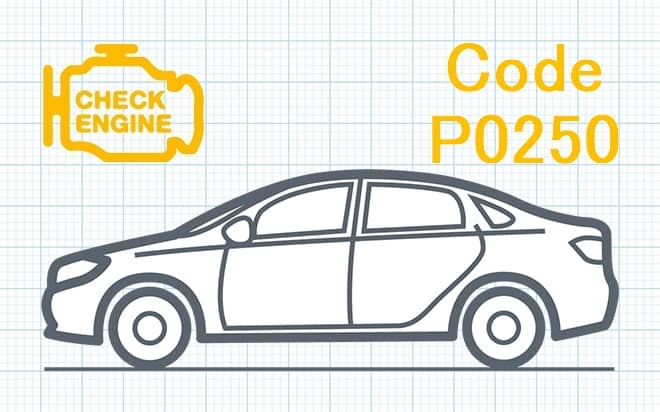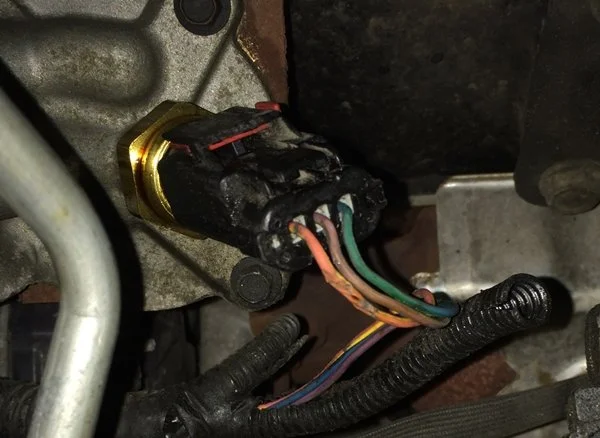
P0250 Turbocharger wastegate solenoid “B” signal high
Content
P0250 – OBD-II Trouble Code Technical Description
Trouble code P0250 indicates that the turbocharger wastegate solenoid “B” signal is too high.
What does the fault code mean P0250?
Trouble code P0250 indicates that the engine control module (ECM) has detected too high voltage in the wastegate solenoid “B” circuit. This may indicate a short circuit to the on-board electrical network of the wires or solenoid.

Possible reasons
Some possible reasons for the P0250 trouble code:
- Bypass valve solenoid malfunction: The solenoid itself may be damaged or malfunctioning due to wear or malfunction.
- Short circuit in solenoid circuit: A short to electrical power or ground may cause the solenoid circuit voltage to be too high.
- Damaged wiring: The wiring connecting the solenoid to the engine control module (ECM) may be damaged, broken, or corroded.
- ECM malfunction: The problem may be due to a malfunction of the engine control module itself, which controls the solenoid.
- Power problems: Insufficient or unstable voltage in the vehicle's power system can also cause this DTC to appear.
- Alternator or battery problems: Alternator or battery problems can cause power problems, which in turn can affect the solenoid's performance.
It is important to conduct detailed diagnostics to accurately determine the cause of the P0250 code on a specific vehicle.
What are the symptoms of a fault code? P0250?
Symptoms for DTC P0250 may include the following:
- Slow or uneven engine response: Excessive voltage in the wastegate solenoid circuit may cause the engine to operate improperly, which may result in slow or uneven throttle response.
- Loss of power: If the wastegate solenoid is activated at the wrong time or to the wrong degree, the engine may experience a loss of power, especially during acceleration or during load.
- Unstable idle mode: High voltage in the solenoid circuit can affect the engine's idle speed, which may result in roughness or even irregular idle speed changes.
- The appearance of errors on the instrument panel: If the ECM detects too high a voltage in the wastegate solenoid circuit, it may result in erroneous messages or indicators on the instrument panel related to engine or boost system operation.
- Acceleration issues: If the solenoid is activated at the wrong time or does not operate correctly, the vehicle may experience acceleration problems, especially under high power demands.
It is important to note that symptoms may vary depending on the specific cause and operating conditions of the vehicle.
How to diagnose a fault code P0250?
To diagnose DTC P0250, follow these steps:
- Checking the error code: Use a scanner to read the error code from the engine control module (ECM).
- Checking the Bypass Valve Solenoid: Check the bypass valve solenoid for damage, corrosion or shorting. Make sure it moves freely and doesn't stick.
- Electrical circuit check: Check the electrical circuit connecting the solenoid to the ECM for corrosion, opens or shorts. Check connections for good contact.
- Voltage test: Use a multimeter to check the voltage in the solenoid circuit. The voltage must be within the permissible values specified in the technical documentation for a particular vehicle.
- Check ECM: If there are no other problems identified, the engine control module may be faulty. Perform additional tests to rule out this possibility.
- Additional tests: Check other components of the boost system, such as pressure sensors and valves, to rule out possible additional problems.
- Clearing the error code: If all problems have been resolved, use a scan tool to clear the error code from the ECM memory.
Diagnostic errors
When diagnosing DTC P0250, the following errors may occur:
- Faulty Solenoid Diagnostics: Incorrectly assessing the condition of the bypass valve solenoid may lead to incorrect identification of the cause of the error.
- Incomplete electrical circuit check: Electrical faults such as breaks, shorts or corrosion may be missed if the diagnosis is incomplete.
- Skipping ECM Check: An engine control module (ECM) malfunction may be missed during diagnosis, resulting in an unsuccessful attempt to resolve the problem.
- Other components are faulty: Mistakenly focusing only on the bypass valve solenoid may cause you to miss other problems in the system that may also cause the P0250 code.
- Wrong solution to the problem: Attempting to solve the problem without proper diagnosis may result in incorrect repairs that will not solve the root cause of the error.
To avoid these errors, it is necessary to carry out a thorough and systematic diagnosis using the correct equipment and following the manufacturer's recommendations.
How serious is the fault code? P0250?
Trouble code P0250 should be taken seriously as it indicates potential problems with the turbocharger control system. Inadequate wastegate solenoid operation can result in poor engine performance, loss of power, and even damage to the engine or other boost system components.
Although the vehicle can continue to drive with this error in most cases, its performance and operating efficiency can be significantly affected. Additionally, ignoring the P0250 code over the long term can lead to more serious problems and damage, requiring more expensive and complex repairs.
Therefore, it is recommended that you contact a qualified auto mechanic or auto repair shop for diagnosis and repair in order to promptly eliminate the cause of the P0250 code and prevent further problems with the vehicle.
What repair will help eliminate the code? P0250?
To resolve DTC P0250, follow these steps:
- Checking and replacing the bypass valve solenoid: If the solenoid is faulty or stuck, it must be replaced.
- Checking and repairing the electrical circuit: Check the electrical circuit connecting the solenoid to the engine control module (ECM). If the wires are broken, short circuited or corroded, they must be replaced or repaired.
- Check and, if necessary, replace the ECM: If other causes have been ruled out, the Engine Control Module (ECM) may need to be inspected and replaced.
- Clearing the error code: After repair, a scan tool must be used to clear the error code from the ECM memory.
It is important to note that to successfully repair a P0250 code, it is recommended that you contact a qualified auto mechanic or auto repair shop. There they will be able to carry out more accurate diagnostics and perform professional repairs using the appropriate equipment and tools.
P0250 – Brand-specific information
Trouble code P0250 relates to the turbocharger control system and can be applied to various makes of cars equipped with turbocharged engines, some of them are:
- Volkswagen/Audi: Wastegate solenoid error may apply to VW and Audi models with turbocharged engines such as Golf, Passat, Jetta, A4, A6 and others.
- BMW: Code P0250 can occur on some BMW models with turbocharged engines such as 3 Series, 5 Series, X3, X5 and others.
- Ford: Some turbocharged Ford models such as Focus ST, Fiesta ST, Fusion and others may also experience this error.
- Mercedes-Benz: Some Mercedes models with turbocharged engines such as C-Class, E-Class, GLC, GLE and others may also have this error code.
- Chevrolet/GMC: Some Chevrolet and GMC models with turbocharged engines, such as the Chevy Cruze, Malibu, Equinox, GMC Terrain and others, may also display the P0250 code.
This is just a small list of brands that the P0250 code may apply to. Each manufacturer may use its own diagnostic codes, so the exact interpretation of the P0250 code may vary depending on the specific make and model of the vehicle.